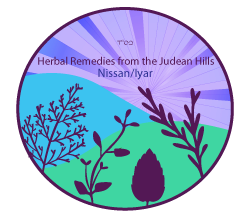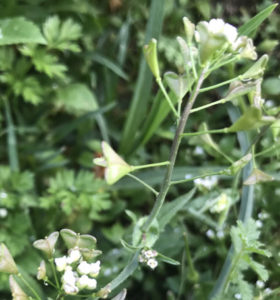Herbal Remedies from the Judean Hills
ילקוט רועים – Shepherd’s Purse – Capsella Bursa-Pastoris
Printable Version
Calming, Comforting, Soothing ‘Mother Heart’ Herb
I happily discovered the petite, gentle, lacy, shepherd’s purse growing in the same spot in my garden in front of our house for the second year in a row. One morning, shepherd’s purse surprisingly greeted me with its typical little, sweet, white four-petaled flowers. I treasure the quiet, modest reassuring strengths of shepherd’s purse, also called ‘Mother Heart,’ due to its tiny heart-shaped pods. “When you eat shepherd’s purse, you become calm. To calm restless, impatient feelings, shepherd’s purse is best of all. They say that if children eat shepherd’s purse, it will cure violent crying tantrums…” (Masanobu Fukuoka). Just as shepherd’s purse is the best plant for arresting excessive female bleeding, it seems as if it also helps the ‘female heart’ from overflowing with the excessive emotion of spiritual bleeding. I have once heard that a spiritual reason for uterine hemorrhage is not having dealt properly with a difficult relationship with one’s mother. Thus, in healing uterine hemorrhage, shepherd’s purse also soothes the negative emotions associated with a difficult mother/daughter relationship. When I sit in my garden with tearful eyes, facing my sweet, little shepherd’s purse, I feel comforted by its soothing motherly spirit. As the wind brushes its lacy leaves against my cheeks, I am once again a little girl sitting in my mother’s lap.
Shepherd’s Purse Stops Excessive Bleeding
Shepherd’s Purse is most renowned for treating abnormally heavy or prolonged menstrual bleeding (menorrhagia), and for shortening bleeding after childbirth. It has a strengthening effect on the uterus and has been used to stop heavy menstrual bleeding due to uterine fibroids, endometriosis, birth-control devices such as IUDs, post hysterectomy surgeries and even peri-menopausal bleeding. This is especially vital for religious couples, who abstain from physical contact seven days after vaginal bleeding has stopped. With the help of shepherd’s purse, the niddah separation period between husband and wife may be shortened for several days, and in some cases even weeks. The herb’s ability to stop bleeding can be attributed not only to its emmenagogue and hemostatic properties but especially to a plant protein that acts like the hormone oxytocin. Oxytocin stimulates contractions of the smooth muscles that support and surround blood vessels, especially those in the womb. Oxytocin also helps to stop bleeding after abortion or delivery. Chemical analyses done on shepherd’s purse have shown that it contains substances able to accelerate the coagulation of the blood. Its energetics are drying and cooling. The herb has a long history of being used to help the womb return to normal size after childbirth. Externally, shepherd’s purse has been used to speed up the healing of minor wounds, cuts and scrapes.
The Separation of Birthing Blood
ספר ויקרא פרק יב פסוק ב דַּבֵּר אֶל בְּנֵי יִשְׂרָאֵל לֵאמֹר אִשָּׁה כִּי תַזְרִיעַ וְיָלְדָה זָכָר וְטָמְאָה שִׁבְעַת יָמִים כִּימֵי נִדַּת דְּוֹתָהּ תִּטְמָא:…(ה) וְאִם נְקֵבָה תֵלֵד וְטָמְאָה שְׁבֻעַיִם כְּנִדָּתָהּ…
“Speak to the children of Israel, saying: If a woman conceives and gives birth to a male, she shall be impure for seven days; as [in] the days of her menstrual flow, she shall be impure. If she gives birth to a female, she shall be impure for two weeks, like her menstruation [period]…” (Vayikra 12:2,5).
When a woman delivers naturally, she enters a state of niddah. This begins from the first sign of blood or from when she feels that delivery is imminent. According to the Torah, the niddah state lasts for seven days after giving birth to a son, and in the case of the birth of a girl, she needs to wait two weeks after childbirth to immerse in a mikvah. Kli Yakar explains the reason why the birth of a girl causes a double impurity period as follows: The original cause of the impurity of the blood of niddah was caused by the first woman, Chava, when she ate from the fruit. Since it was a woman who began the process of bringing impurity into the world, by eating from the forbidden fruit, all women need extra purification. Therefore, when a woman gives birth to a girl she needs a twofold seven-day purification process: one seven-day purification period for herself and one for her daughter (Kli Yakar, Vayikra 12:2). Practically speaking, giving birth to a son or a daughter makes no difference, since, women generally experience bleeding for several weeks after childbirth, and most birthing mothers are unable to count ‘seven clean days’ and immerse in the mikvah until about six weeks after birth.
Shepherd’s Purse for Stopping Hemorrhages of All Kinds
Shepherd’s purse is not only useful for shortening the bleeding of birthing mothers. When dried it yields a tea which is considered by herbalists to be one of the best specifics for stopping hemorrhages of all kinds – of the stomach, the lungs, urinary bleeding, and especially bleeding from the kidneys. Shepherd’s purse was the principal herb in the blue ‘Electric Fluid’ used by Count Matthei to control hemorrhage. Inserting the juice on cotton wool in the nose stops nose bleeding. During World War I, shepherd’s purse was used by soldiers to stop bleeding when other means were not available and inventories of conventional medicine had run out. Shepherd’s purse is mainly used in Chinese herbal medicine to “cool the blood,” and as a treatment for dysentery, high blood pressure and excessive bleeding after birth. It is also known to invigorate blood circulation. According to Culpepper “A good ointment may be made of shepherd’s purse for all kinds of wounds, especially wounds in the head.”
Versatile Uses of Shepherd’s Purse
Shepherd’s Purse is so called from the resemblance of the flat seed-pouches of the plant to an old-fashioned common leather purse. To support wellness, the whole plant in flower is used (except the roots) usually in the form of a tea or infusion. Either fresh or dried works, but fresh is preferred as the dry material soon loses its medicinal properties. Shepherd’s purse has been used as a medicinal herb since ancient times and mentioned as an astringent agent in many medieval medical books. Therefore, it treats hemorrhoids, varicose veins and diarrhea. Its stimulant and diuretic properties cause it to help heal kidney complaints and dropsy. Pedanius Dioscorides (1st century AD) and Pliny the Elder (23-79 AD) describe the seeds of shepherd’s purse as an important laxative that stimulates bowel movements and as an aphrodisiac. It contains vitamins A, B, C and K. Shepherd’s purse tea is an herbal remedy for sore throat, and a natural treatment for urinary tract infection (UTI). It is also useful where uric acid, insoluble phosphates or carbonates produce irritation of the urinary tract. Some herbalists recommend shepherd’s purse as a natural treatment of cystitis, and ailments of the digestive system. Moreover, it is considered to enhance and improve eyesight and vision. This may be due to its high concentrations of potassium and vitamin C, nutrients that are essential in maintaining a healthy iris. Shepherd’s purse is used in soil reclamation as it will absorb excessive salts from the soil, and may be planted for that purpose.
A Bird Favorite and a Mosquito Repellent
Small birds are fond of the seeds of Shepherd’s Purse: chaffinches and other wild birds may often be observed feeding on them, and they are a valuable food for all caged birds.
When poultry have fed freely on the whole green plant in the early spring, it has been noticed that the egg yolks become dark in color and stronger in flavor.
In contrast, the seeds are toxic to mosquito larvae. Since it was thought to drive away mosquitoes, shepherd’s purse was called “life protect plant” in China. Indeed, the seeds (when placed in water) act as a sort of “fly-paper” for mosquitoes, reputedly attracting and trapping them. They also secrete a substance toxic to mosquito larvae and are therefore used as insecticides. A kilogram of seeds is capable of killing 10 million mosquito larvae (Allardice.P. A – Z of Companion Planting. Angus & Robertson 1993).
Culinary Uses
Shepherd’s purse, which is very high in vitamin C, has been used as food for hundreds of years. It is one of the wild greens appearing earliest in the spring. Before the flower stalks appear, the leaves can be added to salads or cooked as greens. When the seeds are ripe, they have a fiery bite that can be utilized as a ‘wild pepper’ or as a substitute for mustard seeds. When the plant flowers, the larger basal leaves tend to die off, leaving only the smaller leaves clasping the stem. They’re still edible, but they get tougher, develop more flavor, and become labor-intensive to collect. Shepherd’s purse is an essential ingredient in the traditional Japanese Nanakusa-Gayu (Seven-Herb Rice Soup).
Hands On
“This plant is a remarkable instance of the truth of an observation which there is too frequently room to make, namely, that Providence has made the most useful things most common, and for that reason we neglect them: few plants possess greater virtues than this, and yet it is utterly disregarded.” – Culpeper’s Herbal, 17th century
Shepherd’s Purse Tea to Arrest Spot Bleeding
2 parts Shepherd’s purse
2 parts Nettle leaf
1 part Raspberry leaf
2 parts Shepherd’s purse
2 parts Nettle leaf
1 part Raspberry leaf
1. Use 4-6 tablespoons of herb mixture per quart of water.
2. Boil water and pour over herbs.
3. Cover tightly and steep 10-20 minutes. Strain.
4. Drink a cup at a time, every half hour until bleeding subsides.
If you start to bleed during pregnancy, make this tea immediately. You must also notify your midwife and/or physician.
https://www.berotbatayin.org
http://www.voices-magazine.com/#
http://www.voices-magazine.com/#



B"H for this knowledge Rebbetzin. This message came right on time. I have experienced excessive uterine bleeding and the doctors are saying they need to perform a hysterectomy. I have never given birth and have been praying for Hashem's mercy. My relationship with my mom has been troubled for many years. We can't be in the same place for long without some type of drama. The memory you have of sitting in your mother's lap is not a memory I share. I love my mother, but don't always like her behavior. The issue with excessive bleeding first started a few years after returning to my home state, around 2014. Three years later and the bleeding is back. Where can I get this Shepherds Purse?
If you are unable to find shepherd's purse growing in nature you should be able to get it in the healthfood store. Email me for further assistance:
Director@www.berotbatayin.org